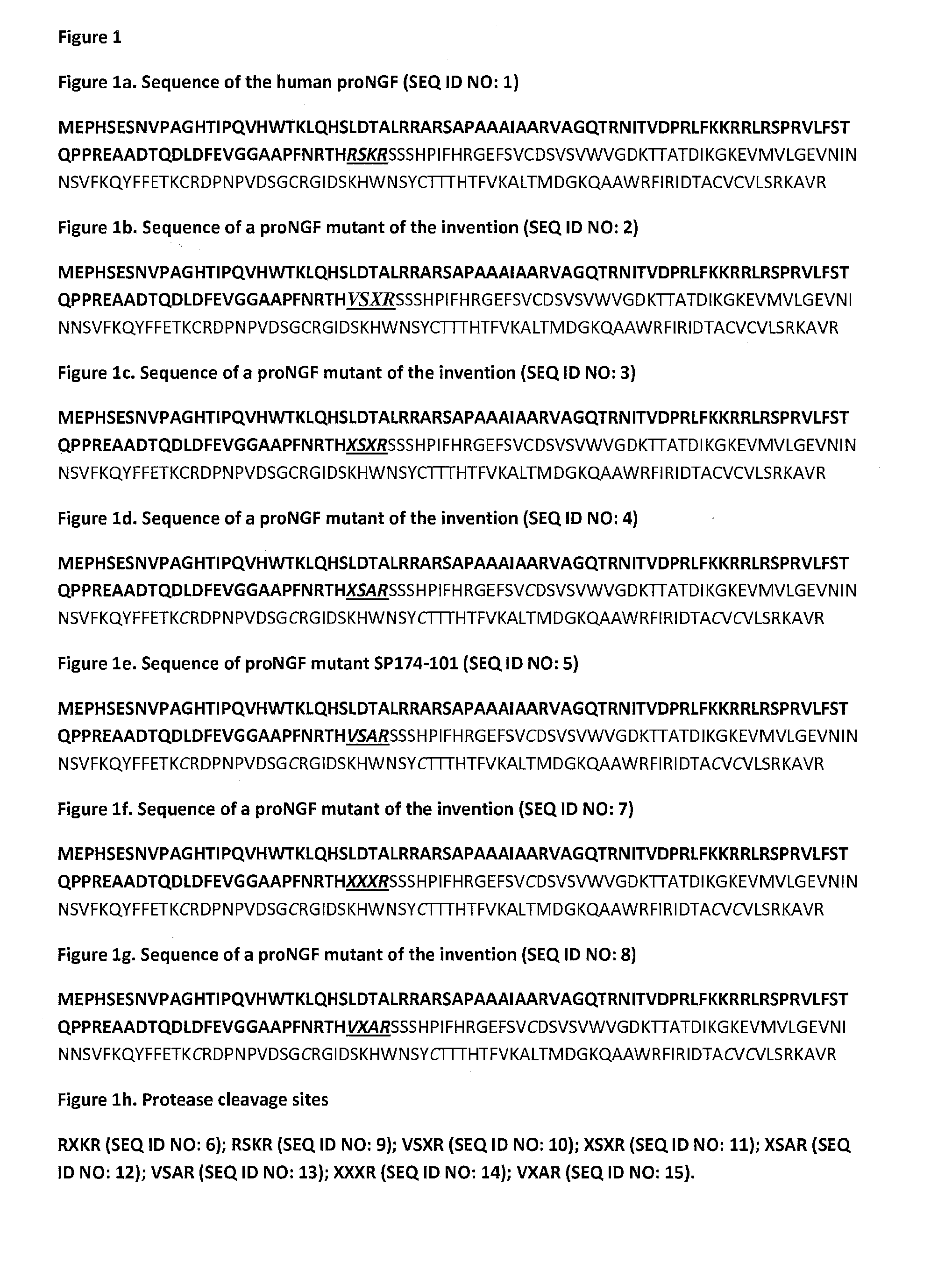Novel prongf mutants and uses thereof in the production of beta-ngf
a technology of prongf and beta-ngf, which is applied in the field of new prongf mutants, can solve the problems of not being suitable for therapeutic use, and achieve the effects of preventing inhomogeneous digestion, increasing the efficiency of cleavage of trypsin, and good yield
- Summary
- Abstract
- Description
- Claims
- Application Information
AI Technical Summary
Benefits of technology
Problems solved by technology
Method used
Image
Examples
example 1
Substitution of Wild-Type Pro NGF at the Protease Cleavage Site at Positions 101 to 104 (R1SK3R4)
[0162]Substitution of Arginine R1 and Lysine K3 corresponding to positions 101 and 103 of human pro-NGF (SEQ ID NO: 1) was realized on DNA level using a synthesized gene by methods as known to someone skilled in the art. Serine in position 102 either remained unchanged or substitution of position 102 of human pro-NGF (SEQ ID NO: 1) was also realized on DNA level using a synthesized gene by methods as known to someone skilled in the art. Lysine K4 corresponding to position 104 was not substituted. Sequences are shown in FIG. 1.
example 2
Recombinant Expression of proNGF Mutant SP174-101 (SEQ ID NO: 5) in Prokaryotic Cells
[0163]The bacterial host E. coli JM108 used for expression of rh-proNGF (DSMZ 5585; F− thi Δ (lac-proAB) end AI gyrA96 relAl phx hsdR17 supE44 recA) is proline-auxotrophic, which was neutralized by the use of the plasmid with the designation pSCIL101. The plasmid pSCIL101 is based on the plasmid pSCIL008 (see WO05061716). The strain cannot synthezise thiamine (Vieira & Messing, 1982 Gene. October; 19(3):259-68). The pro-NGF mutant shown in SEQ ID NO: 5 is expressed under the control of the tac promoter located on pSCIL101. The vector pSCIL101 used here is a high copy plasmid with a kanamycin resistance. The expression is carried out in defined mineral salt medium and is induced by the addition of IPTG. The pro-NGF mutant is deposited in the cytosol in the form of inclusion bodies (IBs).
Cell Line:
[0164]host strain, e.g. E. coli HMS174 (K12) or JM108 (K12)[0165]proNGF mutant SP174-101 (SEQ ID NO: 5)[0...
example 3
[0171]The aim of this fermentation was to obtain product and biomass for subsequent process steps. To monitor the over-expression of the target protein during the fermentation process, samples were analyzed by means of SDS-PAGE before and after induction.[0172]Mineral salt medium without antibiotics[0173]Batch phase μ≈0.25 h−1 (ODend=18)[0174]Fed batch phase I exponential feeding with μset=0.18 h−1 [0175]Fed batch phase II: constant feed rate[0176]Point of induction ODind=60±5[0177]1.0 mM IPTG[0178]Time of induction 5 h[0179]Final OD=82±4[0180]Process time 28.5 h±1.25[0181]Plasmid Stability 100%[0182]Yield: 40 mg / g proNGF; 1.2 g / L 0.2 g / L proNGF
PUM
| Property | Measurement | Unit |
|---|---|---|
| concentration | aaaaa | aaaaa |
| wt. % | aaaaa | aaaaa |
| concentration | aaaaa | aaaaa |
Abstract
Description
Claims
Application Information
 Login to View More
Login to View More - R&D
- Intellectual Property
- Life Sciences
- Materials
- Tech Scout
- Unparalleled Data Quality
- Higher Quality Content
- 60% Fewer Hallucinations
Browse by: Latest US Patents, China's latest patents, Technical Efficacy Thesaurus, Application Domain, Technology Topic, Popular Technical Reports.
© 2025 PatSnap. All rights reserved.Legal|Privacy policy|Modern Slavery Act Transparency Statement|Sitemap|About US| Contact US: help@patsnap.com



